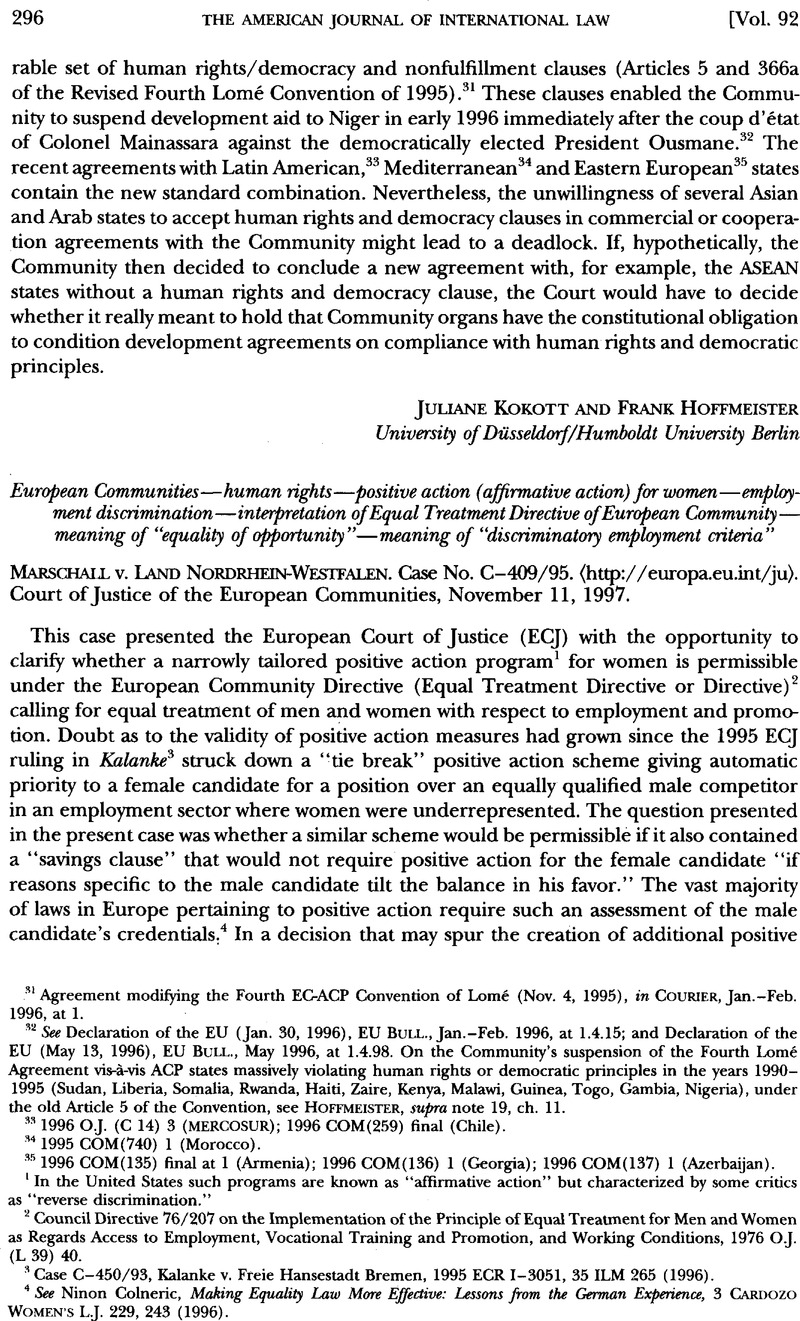No CrossRef data available.
Article contents
Marschall v. Land Nordrhein-Westfalen
Published online by Cambridge University Press: 27 February 2017
Abstract

- Type
- International Decisions
- Information
- Copyright
- Copyright © American Society of International Law 1998
References
1 In the United States such programs are known as “affirmative action” but characterized by some critics as “reverse discrimination.”
2 Council Directive 76/207 on the Implementation of the Principle of Equal Treatment for Men and Women as Regards Access to Employment, Vocational Training and Promotion, and Working Conditions, 1976 O.J. (L 39) 40.
3 Case C-450/93, Kalanke v. Freie Hansestadt Bremen, 1995 ECR 1–3051, 35 ILM 265 (1996).
4 See Ninon, Colneric, Making Equality Law More Effective: Lessons from the German Experience , 3 Cardozo Women’s L.J. 229, 243 (1996)Google Scholar.
5 Agreement on Social Policy Concluded Between the Member States of the European Community with the Exception of the United Kingdom of Great Britain and Northern Ireland, opened far signature Feb. 7, 1992, 31 ILM 358 (1992).
6 See, e.g., Jordan, J. Paust, Race-Based Affirmative Action and International Law , 18 Mich. J. Int’l L. 659, 662–63 (1997)Google Scholar; Bertie, G. Ramcharan, Equality and Nondiscrimination , in The International Bill of Rights: The Covenant on Civil and Political Rights 246, 259–61 (Louis, Henkin ed., 1981)Google Scholar.
7 International Convention on the Elimination of All Forms of Racial Discrimination, Dec. 21, 1965, Art. 1(1)(4), 660 UNTS 195.
8 Article 4(1) reads as follows:
Adoption by States Parties of temporary special measures aimed at accelerating de facto equality between men and women shall not be considered discrimination as denned in the present Convention, but shall in no way entail as a consequence the maintenance of unequal or separate standards; these measures shall be discontinued when the objectives of equality of opportunity and treatment have been achieved.
Convention on the Elimination of All Forms of Discrimination against Women, Dec. 18, 1979, 1249 UNTS 13.
9 Hum. Rts. Committee, General Comment 18, para. 10, quoted in UN Doc. HRI/GEN/1, at 27 (1992) (interpreting the International Covenant on Civil and Political Rights to require affirmative action programs in certain circumstances).
10 Council Recommendation 84/635 on the Promotion of Positive Action for Women, 1984 OJ. (L 331) 334.
11 Id., para. 1.
12 Communication on Kalanke Ruling, Eur. Indus. Rel. Rev., June 1996.
13 Case C-409/95, para. 3 (emphasis added) [hereinafter Marschall]. See Laura, Molinari, The Effect of the Kalanke Decision on the European Union: A Decision with Teeth, But Little Bite , 71 St. Johns L. Rev. 591, 625 n.117 (1997)Google Scholar.
14 Marschall, para. 4.
15 Id., para. 5.
16 Id, para. 20.
17 Id., para. 16.
18 Id.
19 1984 OJ. (L 331) 34, quoted in Marschall, para. 28.
20 Marschall, para. 29.
21 Id., para. 30.
22 Id., para. 35.
23 Id.


